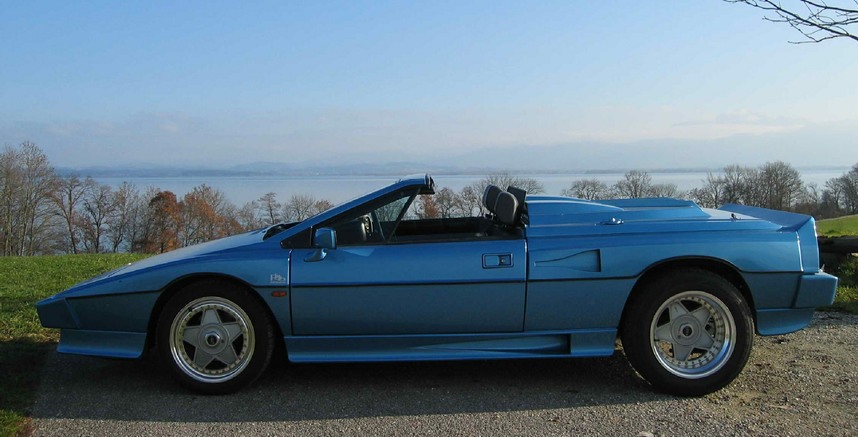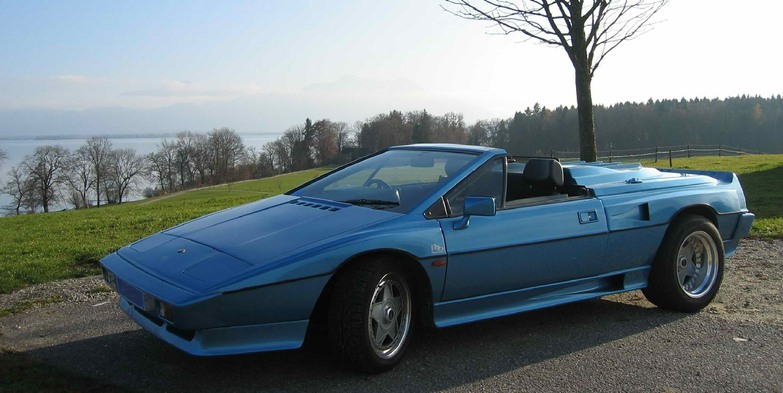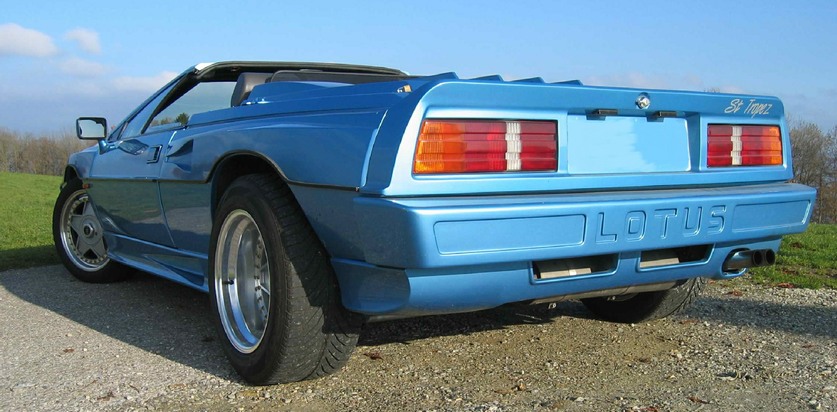


February 2012 - lotusespritconvertible.de
Update 02/2019

LotusEspritConvertible.de Le “Saint Tropez”




It is fun to drive the roadster open.
The shape of the Esprit with the raked windscreen makes the interior nearly free
of turbulence's
up to top speed on the Autobahn. If you like to have more air breeze around your
nose, it is easily adjustable with the height of the side windows.
The hard top can
be fitted quickly and stows on sunny days in the rear boot. The reinforcements developed
with the conversion adds enough rigidity, so the drive is as enjoyable as in the
coupe version.

The so called “St Tropez” convertible conversion was designed and realized from Paul
Bailey. With the background of 15 years in design and manufacturing as an employee
of an engineering company which modified Mercedes, Range Rovers and Rolls Royce's,
he gained a lot of experience in car customizing. His 1987 established company PBB
Design did as well some 10 Jaguar XJS upgrades during the 90´s known as “Monaco”
and other modification work for ambitious customers.


There were only a few St Tropez known to be made so far
The St Tropez roadsters are based on the series S2 and S3 Giugiaro Esprit's only.
The first three conversions were executed by Paul Bailey and his young company PBB Design. based in Bristol, Pilning at that time.
No. 1 “The White” (1989) and No. 2 “The Blue” (1990) were for sure no customer jobs. PBB had to verify with performed conversions, that the finished cabriolet will be still an Esprit to drive with. As the second Esprit roadster was even more a strong Turbo model, which proofed that the cabriolet had still a refined road handling, the first customer chop job arrived soon after as No. 3 “The Yellow” (1991), a S2 model with a Rover V8 under the bonnet.
The latter ones were claimed to be finished by Esprit Developments, as Mark Irwin had taken over the moulds, drawings and rights for the St Tropez conversion from PPB after his own “The Yellow” St Tropez No. 3 was finished.


All St Tropez, pictures of No 2
St Tropez with Rover V8, driving impressions No 3
All St Tropez, pictures of red St Tropez with wing
All St Tropez, pictures of No 1-6
Filmclips:
Video on youtube from the Castle Combe Super Car Test Day 1990,
video coverage from No. 1 white St Tropez and No. 2 blue St Tropez @ 31:45 min. and 45:43 min
comment from Darren Styles, Editor of “World Sports Cars” magazine
Publications in magazines:
World Sportscars, July/Aug 1989, page 38-43, St Tropez No. 1, page 7 Stevens Esprit convertible design sketch
Top Car, Oct 1991, page 52-55, St Tropez No. 2
Men Only, 1992, Volume 57, Number 9, page 19, St Tropez No. 2
Classic Cars, Sep. 2006, page 47, St Tropez No. 2
Club Lotus News, 1992/2, Cover St Tropez No. 2, page 39, St Tropez No. 3
Top Car, May 1992, page 74-77, St Tropez No. 3
Publications in books:
Lotus Esprit – The Complete Story by Jeremy Walton, 1991, page 49, St Tropez No. 2
The Illustrated Motorcar Legends – Lotus by Roy Bacon, 1995, page 70-71, St Tropez No. 2
Lotus – Historic Half Century by Graham Capel, 1998, cover and page 36, St Tropez No. 2
Lotus – The Creative Edge by Russell Hayes, 2007, page 119, St Tropez No. 2
Lotus Esprit – Le grand tourisme à l’ anglaise by Rémy Solnon, 2007, page 142-143, St Tropez No. 2

I had seen Paul Baileys second blue St Tropez in a couple of Esprit books and always
found the look to be a real vision. I esteem him for realizing his dream of a convertible
Esprit.
The design is not perfect from every angle on the pictures, but the overall
appearance is amazing when you see the roadster outside in the sun.
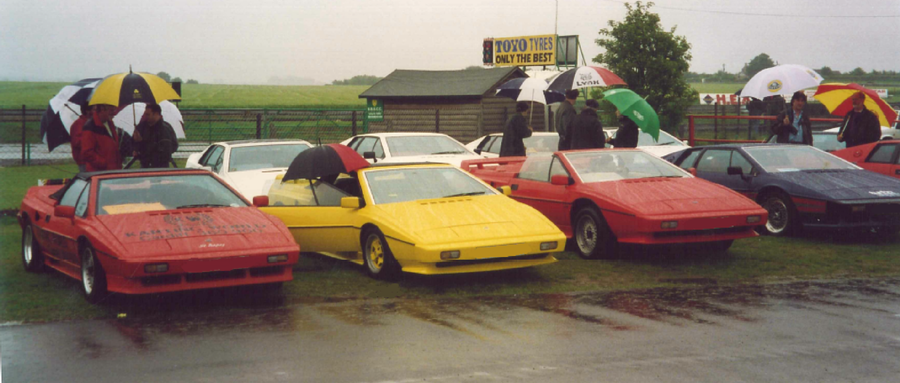
A seldom view - 3 St Tropez united at Castle Combe in the mid 90’s
What has been modified?
Chopping of the roof behind the windscreen and the C buttresses of the rear upper body including removal of the tailgate was the first action. The now missing parts were replaced with new body panels made out of glass fiber resin compound. Mouldings were manufactured up front and gave the new parts a perfect surface finish. The new tailgate is a stiff bonnet with an internal sub frame for strengthening. Opening is supported with a mechanical spring supported scissor device.
The front and rear wheel arches were widened to give the car a more beefy appearance. Some of the cars stayed with original wheels, others got Compomotive three-piece alloy wheels with extended rim size in diameter and width. The better filling of the wheel arches with the bigger rubber suited the broadened wings very well.
To accommodate the newly developed hard top / soft top combination with foldable pillars in the rear boot behind the engine, the boot compartment was modified partly with new center panels. Now the removable roof slides in quite comfortable and is a snug fit in there. As the body is now missing the C buttresses, the rear chassis got a triangulated extension which supports the body in the aft section.
At the front, the A posts around the windscreen were strengthened with mild steel tubing. Additionally, inside the lower sills runs now a twin tube steel bracing on each side which prevents the chassis from twisting.
To support the engine bay venting through the sills, Naca air intakes near the seam line on either side were added. The left one supports venting for additional engine bay cooling like introduced from Lotus for the hc Esprit's in 1986 on the exhaust side. The right Naca duct feeds the two twin carburetors with ram air. The hot engine bay air escapes through the six large vents in the middle of the bonnet.
As this sums up to an awful lot of labour and parts involved, the basic conversion without new wheels was already quite pricey even for the early 1990´s with a price tag of 4500 £ including a full respray.
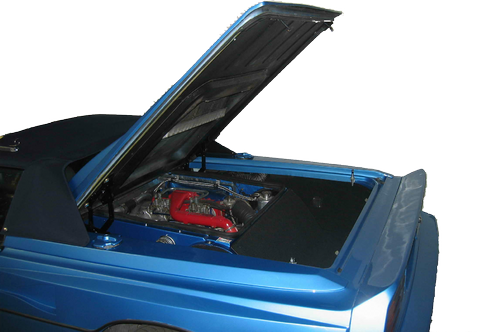
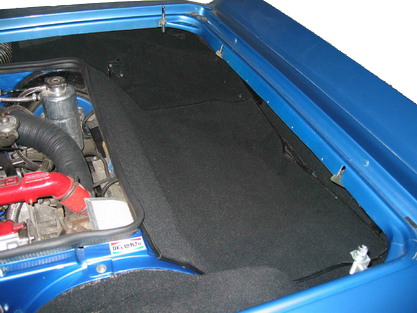
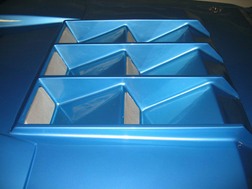
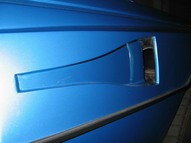
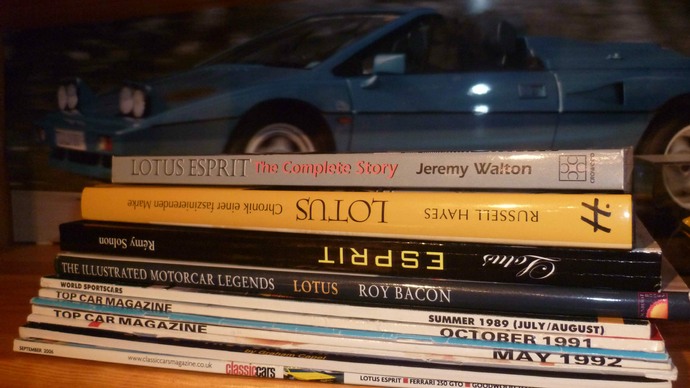 Back to top
Back to top
